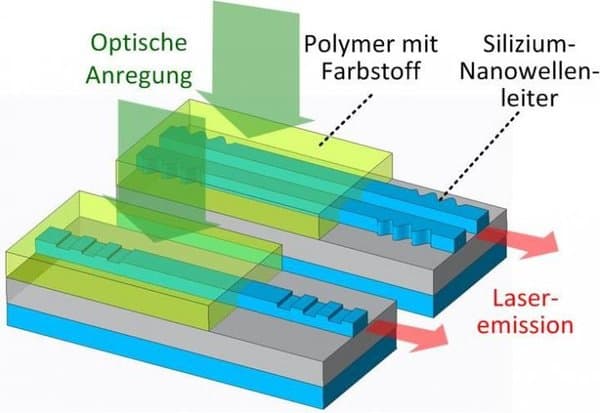Researchers Integrate A Laser Source On A Silicon Photonic Chip
In recent times, scientists have been working hard to achieve nanophotonics integration in the field of bioscience, in order to artificially develop, flexible and portable technologies to cure physical and semi-physical anomalies. A very recent breakthrough in this regard can be attributed to Christian Koos and his team from the Karlsruher Institutfür Technologie’s Institute of Photonics and Quantum Electronics (IPQ).
For the first time, the group realised a LASER source with an organic gain medium, and have grown the structure on a silicon wafer to create a bio-sensor. This work is worth noting because of its possible applications in the field of medical science, through which a non-invasive diagnosis for patients can be conducted.
Team leader Koos explained that they have gone through a challenging task of incorporating different optical components on a single chip, without hiking the cost. A newly developed sub field, known as silicon photonics depends upon the nanotechnological fabrication process of microelectronic devices, which however scales up the production of inexpensive photonic components. These tiny components are essential tools for information technology and biosensors.

Organic laser on a silicon photonic chip
Though the methodology has developed through years of experiments, integrating a LASER source on a chip was not achievable as the nature of a semiconductor structure works against that of light emitters. When an electron jumps from one energy state to another energy state, the energy is released in the form of heat, rather in the form of vibrations, whose quanta are known as phonons, instead of photons which are necessary to release light.
To observe the required results, KIT researchers have engineered LASER sources in the infrared range. Laboratory processes include the incorporation of silicon nano-waveguides with polymer doped organic die, and the working force comes from a horizontally placed light source. The complete system was able to produce radiation of 1310 nm wavelength and a peak power of greater than 1 Watt per chip. The complete research report was published in the Nature Communications journal.
Source: <a href="https://www.kit.edu/kit/english/pi_2016_034_nature-communications-laser-source-for-biosensors.php" target="_blank" rel="nofollow noopener noreferrer">KIT - KIT - Media - Press Releases - Archive Press Releases - Nature Communications: Laser Source for Biosensors</a>
For the first time, the group realised a LASER source with an organic gain medium, and have grown the structure on a silicon wafer to create a bio-sensor. This work is worth noting because of its possible applications in the field of medical science, through which a non-invasive diagnosis for patients can be conducted.
Team leader Koos explained that they have gone through a challenging task of incorporating different optical components on a single chip, without hiking the cost. A newly developed sub field, known as silicon photonics depends upon the nanotechnological fabrication process of microelectronic devices, which however scales up the production of inexpensive photonic components. These tiny components are essential tools for information technology and biosensors.

Organic laser on a silicon photonic chip
Though the methodology has developed through years of experiments, integrating a LASER source on a chip was not achievable as the nature of a semiconductor structure works against that of light emitters. When an electron jumps from one energy state to another energy state, the energy is released in the form of heat, rather in the form of vibrations, whose quanta are known as phonons, instead of photons which are necessary to release light.
To observe the required results, KIT researchers have engineered LASER sources in the infrared range. Laboratory processes include the incorporation of silicon nano-waveguides with polymer doped organic die, and the working force comes from a horizontally placed light source. The complete system was able to produce radiation of 1310 nm wavelength and a peak power of greater than 1 Watt per chip. The complete research report was published in the Nature Communications journal.
Source: <a href="https://www.kit.edu/kit/english/pi_2016_034_nature-communications-laser-source-for-biosensors.php" target="_blank" rel="nofollow noopener noreferrer">KIT - KIT - Media - Press Releases - Archive Press Releases - Nature Communications: Laser Source for Biosensors</a>
0
